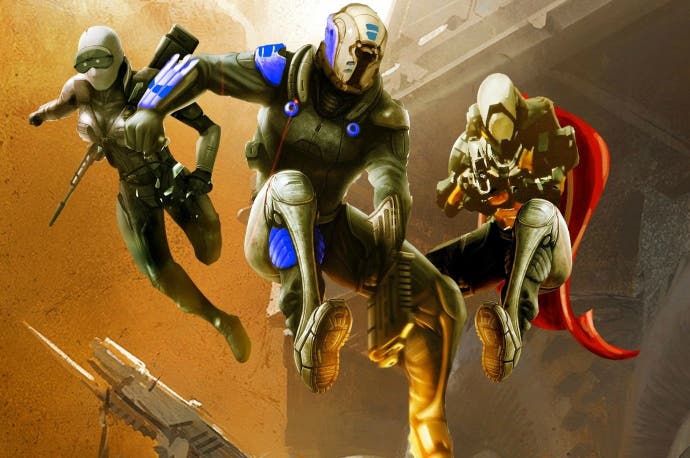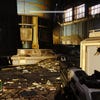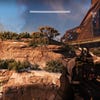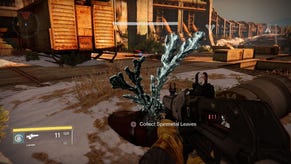Tech Analysis: Destiny alpha on PS4
Digital Foundry gets to grips with Activision's $500m game.
As its first cross-generation, multi-platform release, Destiny represents a huge undertaking for Bungie. With just a scant few months left until its release we still have yet to see the game running on anything other than PlayStation 4, leaving many questions hanging. Just how scalable is this engine? What level of performance will other platforms deliver? At the very least, things are looking up for the Xbox One version with the recent revelation that the updated Xbox One XDK allows Bungie to hit 1080p30 rather than the previously rumoured 900p. But in the here and now, it's all about PS4 - and based on the rich quality of the alpha code released this week, that's absolutely fine by us.
Right from the start, Destiny feels like the maturation of the core principles and technologies on which Bungie's classic Xbox 360 games were built. There was always a lingering sense that the studio never fully delivered on the full promise of its last-generation vision, with sub-720p resolutions and other visual compromises preventing the art from truly shining. Based on our experience with the Destiny alpha on PS4, it feels as though the studio has reached its goal, delivering the no-compromise experience we've been waiting for. No wonder then that Activision is backing this game so strongly, with a reported $500m budget for this grand new IP.
It starts with image quality. Memory and performance constraints on Xbox 360 ultimately limited what the studio could accomplish last generation and left us with sometimes-rough image quality - especially on its pre-Halo Reach offerings. On PS4, the jump to full 1080p resolution makes a massive difference. With the focus on massive worlds filled with far-reaching detail, the move to a higher resolution dramatically improves the experience. Moving away from the experiments with temporal anti-aliasing has instead lead to what appears to be the now commonplace FXAA. While the image is sharp and relatively clean, certain subtle details appear slightly blurred as a result of this. Regardless, the end results are vastly superior to any previous Bungie release and allow its artwork to shine in a way it previously could not.
"With Destiny on PS4, it feels as if Bungie has finally delivered the no-compromise experience it has always striven for."
While Destiny may have one foot rooted in the last generation, the current state of its technology is actually quite modern. Last summer, following E3, Bungie delivered a presentation at Siggraph 2013 detailing the advancements and technology behind Destiny. Plenty of interesting information was revealed, but a lot can change in a year. With this in mind, we were curious to see how many of the promised features have made the cut at this point in time. First and foremost, the team has transitioned to a fully deferred rendering solution, as opposed to a partial approach used in Halo Reach, resulting in a lavish array of dynamic lights. We're unsure about the global illumination tech, but the overall effect still impresses, enabling brilliant outdoor sequences alongside more dynamic interiors capable of being entirely lit, or darkened, by a variety of light sources. Light appears to react to and refract off surfaces in a very realistic and natural fashion, working supremely well with the 60-minute day/night cycle. Light shafts are also used liberally throughout the experience alongside ample lens flares and light coronas.
Shadows play a key role in defining the look of the game both indoors and out. Soft shadows stretch realistically across the world based on the positioning of the primary light source. A form of variance shadow maps (EVSM) is used to create more realistic shadows in a wider variety of lighting conditions. The strength of the light casting each shadow helps determine the shadow intensity - shadows cast within shadow appear different from those cast by a bright spotlight, as an example. Indoors, when the lights disappear, there are moments when we see Doom 3-style shadow volumes extend from geometry edges while using the flashlight.
Shadows are further enhanced by high-quality HDAO implementation used throughout the game. The effect is subtle but effective and manages to sidestep obvious visual artefacts. We occasionally observed shadow-flickering at sharp angles but this was relatively uncommon. It's clear that a lot of attention was placed on creating properly lit and shaded environments with minimal artefacts and, aside from some loss of resolution at a distance, the results are generally solid.
"There's no single technique here that pushes Bungie's tech beyond the competition, but everything is executed very well and creates a beautiful end result."
Another key element in the visual composition of Destiny is its post-processing pipeline. Depth of field and motion blur are used extensively throughout the game in an evolution of the techniques seen in the Xbox 360 Halo titles. Motion blur is selectively applied to the image, mostly around the edges, as opposed to filling the entire field of view. It's a more subtle approach, but it looks great. The effect itself uses a high number of samples, almost completely eliminating artefacts in the process. The only complaint one might level at the implementation is the general lack of per-object blur - the exaggerated animations would benefit greatly from this technique and its absence is a touch disappointing. On top of this, the depth of field implementation used for iron sights is excellent, created using circular bokeh-style elements instead of the less desired hexagon patterns.
With a strong lighting system, clean shadows, and plenty of post-processing already in check we turn to the more subtle elements used to create a more believable world. The game uses a huge number of decorators and foliage, many of which take wind and character collision into account, providing a richly detailed, active environment. Cloth simulation is used for capes, flags, and sashes as well while groups of birds react to passing players realistically.
Water caustics are also taken into account and react accordingly, although the simulation actually appears somewhat less detailed than the geometric mesh used in Halo 3 - a simulation that was remarkable for its day, so it's a bit disappointing to see the effect pared back in Destiny. At least the use of screen-space reflections creates more attractive bodies of water from a normal distance. More controversially, perhaps, Destiny also makes use of both chromatic aberration and a dirty lens texture when looking into bright lights. At least in this case, these characters are utilising helmets that could very easily suffer from such issues on the battlefield.
Textures are generally of high resolution, with plenty of detail even under close examination but this is somewhat tempered by the spotty anisotropic filtering implementation. It seems to be applied in a selective fashion with some surfaces appearing relatively clean at oblique angles while others lose quite a bit of detail.
"Performance wise, Destiny delivers a stable 30fps regardless of on-screen action interrupted only by some unfortunate frame-pacing issues."
Mentioned in the Siggraph presentation, and visible in last year's demo were instances of tessellation (or, on reflection, perhaps parallax occlusion mapping). It's difficult to say based only on this alpha release but it certainly appears to be absent in our experience. The environment certainly doesn't appear to benefit from this effect (we couldn't find examples like the ones we saw during E3 last year) while obvious edges remain visible on character models as well. The amount of scene geometry present at any time is still relatively impressive, however, with massive, detailed scenes visible from any distance, but it's disappointing that some of the smaller details aren't fleshed out further. At least enemies and objects appear to be visible from great distances, deftly avoiding any noticeable pop-in throughout.
Performance wise, Destiny delivers a stable 30fps regardless of on-screen action, interrupted only by issues with frame-pacing. There are regularly instances in which a singular frame remains on-screen for an additional 16.7ms, creating a run of three identical frames, followed by a single frame. This interrupts the cadence of frames required to deliver a stable 30fps, creating a slight judder during motion. This issue manifests itself in our consistency graphs as a series of spikes and dips at random intervals - as opposed to the flat 33ms line you'd get from a locked 30fps title with appropriate frame-pacing.
The game appears to have no troubles maintaining a consistent level of performance both in normal missions and multiplayer but the ordering of certain frames gives the impression of subtle frame-rate hiccups leading to a less fluid experience. What's interesting is that there is a history of this issue with Bungie games even on Xbox 360. While Halo Reach was free of this defect, both Halo 3 and Halo ODST suffered from a very similar issue. It was something some of us noticed back in 2007 but weren't fully able to understand what was causing it at the time. Thankfully, unlike those titles, Destiny manages to completely avoid any additional drops in performance, producing an overall smoother experience - but we can't help but wonder if this is a simple bug that could be easily patched, as we saw with a very similar scenario in Need for Speed Rivals.
"Time-lapse video demonstrates the exceptional detail that Bungie has put into its world-building."
There's still a fair amount of time to wait until Destiny is ready for its debut on store shelves but, at this point, it's shaping up to be one of the most beautiful cross-gen games in development. There's no single technique here that pushes Bungie's technology beyond the competition, but everything is executed very well and creates a cohesive, beautiful end result. For the most part, the features detailed in the studio's presentation last year appear to be fully accounted for and the 2013 demo is generally representative of what we experienced in the alpha. The most significant flaw remains the frame-pacing issue, which we would very much like to see addressed in the final product as it would have a positive impact on the fluidity of the experience.
With the PS4 shaping up to be a solid experience, we can only wonder what will become of the other versions. Bungie is quick to wax poetic on the scalability of its latest engine, so it will certainly be quite a treat to see how it handles last-generation consoles in particular. The eDRAM limitations on Xbox 360 certainly haven't disappeared and the potential troubles running on the Cell processor and the PS3's split memory architecture should be interesting.
What we can say for now is simply that Destiny is shaping up to be a classic shooter. Despite sharing similarities with games such as Borderlands and of course the studio's own Halo titles, Bungie's attention to detail and incredibly polished combat results in something decidedly special. Few developers manage to pull off world-building quite like Bungie and it's fantastic to see the technology fully pulling its weight in delivering a unique vision. When September finally arrives you can be certain that Digital Foundry will finally put all four versions to the test - and of course, we'll be checking out the beta code next month with much interest.





















